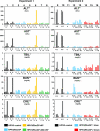Successful topical respiratory tract immunization of primates against Ebola virus
- PMID: 17428868
- PMCID: PMC1900097
- DOI: 10.1128/JVI.00105-07
Successful topical respiratory tract immunization of primates against Ebola virus
Abstract
Ebola virus causes outbreaks of severe viral hemorrhagic fever with high mortality in humans. The virus is highly contagious and can be transmitted by contact and by the aerosol route. These features make Ebola virus a potential weapon for bioterrorism and biological warfare. Therefore, a vaccine that induces both systemic and local immune responses in the respiratory tract would be highly beneficial. We evaluated a common pediatric respiratory pathogen, human parainfluenza virus type 3 (HPIV3), as a vaccine vector against Ebola virus. HPIV3 recombinants expressing the Ebola virus (Zaire species) surface glycoprotein (GP) alone or in combination with the nucleocapsid protein NP or with the cytokine adjuvant granulocyte-macrophage colony-stimulating factor were administered by the respiratory route to rhesus monkeys--in which HPIV3 infection is mild and asymptomatic--and were evaluated for immunogenicity and protective efficacy against a highly lethal intraperitoneal challenge with Ebola virus. A single immunization with any construct expressing GP was moderately immunogenic against Ebola virus and protected 88% of the animals against severe hemorrhagic fever and death caused by Ebola virus. Two doses were highly immunogenic, and all of the animals survived challenge and were free of signs of disease and of detectable Ebola virus challenge virus. These data illustrate the feasibility of immunization via the respiratory tract against the hemorrhagic fever caused by Ebola virus. To our knowledge, this is the first study in which topical immunization through respiratory tract achieved prevention of a viral hemorrhagic fever infection in a primate model.
Figures



References
-
- Baskerville, A., E. T. Bowen, G. S. Platt, L. B. McArdell, and D. I. Simpson. 1978. The pathology of experimental Ebola virus infection in monkeys. J. Pathol. 125:131-138. - PubMed
-
- Brown, T. A., B. R. Murphy, J. Radl, J. J. Haaijman, and J. Mestecky. 1985. Subclass distribution and molecular form of immunoglobulin A hemagglutinin antibodies in sera and nasal secretions after experimental secondary infection with influenza A virus in humans. J. Clin. Microbiol. 22:259-264. - PMC - PubMed
-
- Buchholz, U. J., S. Finke, and K. K. Conzelmann. 1999. Generation of bovine respiratory syncytial virus (BRSV) from cDNA: BRSV NS2 is not essential for virus replication in tissue culture, and the human RSV leader region acts as a functional BRSV genome promoter. J. Virol. 73:251-259. - PMC - PubMed
Publication types
MeSH terms
Substances
Grants and funding
LinkOut - more resources
Full Text Sources
Other Literature Sources
Medical
Miscellaneous

